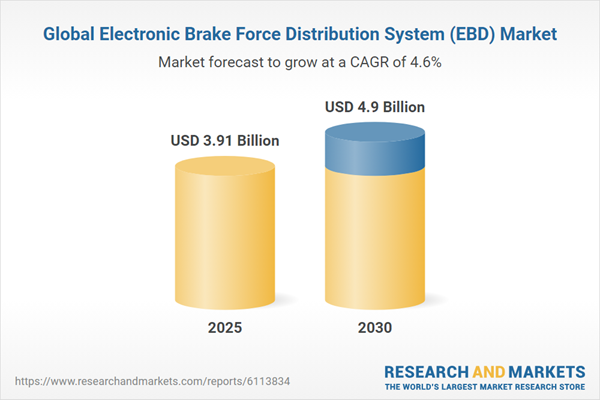The global automotive electronic brake force distribution (EBD) market is experiencing growth driven by the increasing demand for enhanced vehicle safety and improved driving experiences. EBD, a critical subsystem of anti-lock braking systems (ABS) and electronic stability control (ESC), optimizes braking by dynamically adjusting the force applied to each wheel based on variables such as road conditions, vehicle speed, and load distribution. This technology ensures maximum stopping power while maintaining vehicle stability, reducing the risk of skidding or loss of control. EBD is particularly vital as it compensates for weight shifts during braking, applying less pressure to the rear wheels to prevent locking, especially since front wheels bear most of the vehicle’s weight.
Technical Overview
EBD operates by integrating wheel speed sensors, brake force accumulators, and an electronic control unit (ECU). The wheel speed sensors monitor each wheel’s speed and calculate the slip ratio, relaying this data to the ECU. The ECU then signals the brake force accumulators to apply the appropriate braking force to each wheel. This synergy with ABS, which prevents wheel lockup by gradually applying braking force, and ESC, which mitigates understeer or oversteer during turns, enhances overall vehicle control and safety. The demand for such integrated safety systems is a key driver of the EBD market’s expansion.Market Segmentation
The EBD market is segmented by vehicle type, sales channel, and geography:Vehicle Type: The market is divided into passenger vehicles, light commercial vehicles, and heavy commercial vehicles. Passenger vehicles dominate the market share due to rising production and consumer demand for safer personal transportation.
Sales Channel: The market splits into original equipment manufacturers (OEMs) and the aftermarket. OEMs hold a significant share, as most new vehicles are equipped with EBD systems integrated with ABS modules during production.
Geography: The market is segmented into North America, Europe, Middle East & Africa, Asia-Pacific, and South America. North America leads due to high automobile production, increasing demand for vehicles, and a strong emphasis on safe and convenient driving systems.
Competitive Landscape
The EBD market is highly competitive, with a mix of international, regional, and local players. Key strategies include technological innovation, product development, and strategic investments to strengthen market presence. Companies are focusing on integrating advanced safety features to meet regulatory and consumer demands.Recent Developments
Notable advancements include Toyota’s announcement that all new vehicle variants will feature ABS and EBD as standard safety components, reflecting the industry’s shift toward prioritizing safety. Additionally, regulatory bodies like the National Highway Traffic Safety Administration (NHTSA) have pushed for mandatory automatic emergency braking systems, further boosting the adoption of EBD and related technologies.Conclusion
The global EBD market is poised for continued growth, driven by the critical role of EBD in enhancing vehicle safety and stability. Its integration with ABS and ESC, coupled with increasing regulatory mandates and consumer demand for safer vehicles, positions EBD as a cornerstone of modern automotive safety systems.Key Benefits of this Report:
- Insightful Analysis: Gain detailed market insights covering major as well as emerging geographical regions, focusing on customer segments, government policies and socio-economic factors, consumer preferences, industry verticals, and other sub-segments.
- Competitive Landscape: Understand the strategic maneuvers employed by key players globally to understand possible market penetration with the correct strategy.
- Market Drivers & Future Trends: Explore the dynamic factors and pivotal market trends and how they will shape future market developments.
- Actionable Recommendations: Utilize the insights to exercise strategic decisions to uncover new business streams and revenues in a dynamic environment.
- Caters to a Wide Audience: Beneficial and cost-effective for startups, research institutions, consultants, SMEs, and large enterprises.
What do businesses use our reports for?
Industry and Market Insights, Opportunity Assessment, Product Demand Forecasting, Market Entry Strategy, Geographical Expansion, Capital Investment Decisions, Regulatory Framework & Implications, New Product Development, Competitive IntelligenceReport Coverage:
- Historical data from 2022 to 2024 & forecast data from 2025 to 2030
- Growth Opportunities, Challenges, Supply Chain Outlook, Regulatory Framework, and Trend Analysis
- Competitive Positioning, Strategies, and Market Share Analysis
- Revenue Growth and Forecast Assessment of segments and regions including countries
- Company Profiling (Strategies, Products, Financial Information, and Key Developments among others).
Segmentation
By Component
- Hardware
- Software
By Vehicle Type
- Passenger Vehicle
- Light Commercial Vehicle
- Heavy Commercial Vehicle
By Sales Channel
- OEMs
- Aftermarket
By Geography
- North America
- USA
- Canada
- Mexico
- South America
- Brazil
- Argentina
- Others
- Europe
- Germany
- France
- United Kingdom
- Spain
- Others
- Middle East and Africa
- Saudi Arabia
- Israel
- UAE
- Others
- Asia Pacific
- China
- Japan
- South Korea
- India
- Indonesia
- Thailand
- Taiwan
- Others
Table of Contents
Companies Mentioned
- Continental AG
- Robert Bosch GmbH
- ZF Friedrichshafen AG
- Toyota Group
- Brembo N.V.
- Akebono Brake Industry Co., Ltd.
Table Information
| Report Attribute | Details |
|---|---|
| No. of Pages | 140 |
| Published | June 2025 |
| Forecast Period | 2025 - 2030 |
| Estimated Market Value ( USD | $ 3.91 Billion |
| Forecasted Market Value ( USD | $ 4.9 Billion |
| Compound Annual Growth Rate | 4.6% |
| Regions Covered | Global |
| No. of Companies Mentioned | 6 |









